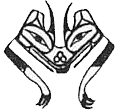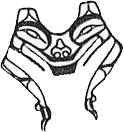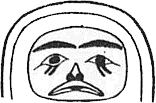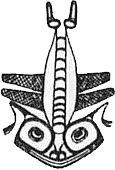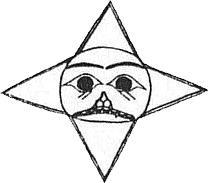In February 1879 I
was fortunate enough to meet a party of Haida men and women in Port
Townsend, Washington, who permitted me to copy their tattoo marks.
The tattoo marks of
the Haidas are heraldic designs or the family totem, or crests of the
wearers, and are similar to the carvings depicted on the pillars and
monuments around the homes of the chiefs, which casual observers have
thought were idols. These designs are invariably placed on the men
between the shoulders just below the back of the neck, on the breast,
on the front part of both thighs, and on the legs just below the
knees. On the women they are marked on the breast, on both shoulders,
on both forearms, from the elbow down over the back of the hands to
the knuckles, and on both legs below the knee to the ankle.
When the Haidas visit
Victoria or the town on Puget Sound they are dressed in the garb of
white people and present a respectable appearance, in marked contrast
with the Indians from the west coast of Vancouver Island, or the
vicinity of Cape Flattery, who dress in a more primitive manner, and
attract notice by their more picturesque costumes than do the Haida,
about whom there is nothing outwardly of unusual appearance, except
that tattoo marks on the hands of the women, which show their
nationality at a glance to the most careless observer.
Almost all of the
Indian women of the northwest coast have tattoo marks on their hands
and arms, and some on the face; but as a general thing these marks are
mere dots or straight lines having no particular significance. With
the Haidas, however, every mark has its meaning; those on the hands
and arms of the women indicate the family name, whether they belong to
the bear, beaver, wolf or eagle totems, or any of the family of
fishes. As one of them quaintly remarked to me, "If you were
tattooed with the design of a swan, the Indians would know your family
name."....
Although it is very
easy to distinguish the Haida women from those of other tribes by
seeing the tattoo marks on the backs of their hands, yet very few
white persons have cared to know the meaning of these designs, or are
aware of the extent of the tattoo marks on the persons of both sexes.
It should be borne in
mind that during their festivals and masquerade performances the men
are entirely naked and the women have only a short skirt reaching from
the waist to the knee; the rest of their persons are exposed, and it
is at such times that the tattoo marks show with the best effect, and
the rank and family connection are known by the variety of designs.
Like all the other
coast tribes, the Haidas are careful not to permit the intrusion of
white persons or strangers to their Tomanawos ceremonies, and as a
consequence but few white people, and certainly none of those who have
ever written about those Indians, have been present at their opening
ceremonies when the tattoo marks are shown.
My information was
derived from the Haidas themselves, who explained to me while I was
making the drawings, and illustrated some of the positions assumed in
their dances by both sexes. As the Haidas, both men and women, are
very light colored, some of the latter, full blooded Indians too,
having their skins as fair as Europeans, the tattoo marks show very
distinct.
This tattooing is not
all done at one time, nor is it everyone who can tattoo. Certain ones,
almost always men, have a natural gift which enables them to excel in
this kind of work. One of the young chiefs, named Geneskelos, was the
best designer I knew, and ranked among his tribe as a tattooer. He
belonged to Laskeek village on the east side of Moresby's Island, one
of the Queen Charlotte group. I employed him to decorate the great
canoe which I sent to the Centennial Exposition at Philadelphia in
1879, for the National Museum. I was with him a great deal of the time
both at Victoria and Port Townsend. He had a little sketch book in
which he had traced designs for tattooing, which he gave to me. He
subsequently died in Victoria of smallpox, soon after he had finished
decorating the canoe.
He told me the plan
he adopted was first to draw the design carefully on the person with
some dark pigment, then prick it in with needles, and then rub over
the wound with some more coloring matter till it acquired the proper
hue. He had a variety of instruments composed of needles tied neatly
to sticks. His favorite one was a flat strip of ivory or bone, to
which he had firmly tied five or six needles, with their points
projecting beyond the end just far enough to raise the skin without
inflicting a dangerous wound, but these needle points stuck out quite
sufficiently to make the operation very painful, and although he
applied some substance to deaden the sensation of the skin, yet the
effect was on some to make them quite sick for a few days;
consequently, the whole process of tattooing was not done at one time.
As this tattooing is a mark of honor, it is generally done at or just
prior to a Tomanawos performance and at the time of raising the
heraldic columns in front of the chief's house. The tattooing is done
in open lodge and is witnessed by the company assembled. Sometimes it
takes several years before all the tattooing is done, but when
completed and the person well ornamented, then they are happy and can
take their seats among the elders.
It is an interesting
question, and one worthy of careful and patient investigation, why it
is that the Haida Nation alone of all the coast tribes tattoo their
persons to such an extent, and how they acquire the art of carving
columns which bear such striking similarity to carving in wood and
stone by the ancient inhabitants of Central America, as shown by
drawings in Bancroft's fourth volume of Native Races and in Habel's
investigation in Central and South America.
The tattoo marks, the
carvings, and heraldic designs of the Haida are an exceedingly
interesting study, and I hope what I have thus hastily and imperfectly
written may be the means of awakening an interest to have those
questions scientifically discussed, for they seem to me to point to a
key which may unlock the mystery which for so many ages has kept us
from the knowledge of the origin of the Pacific Tribes.
The custom which
prevails among them, and seems to be a distinctive feature of this
tribe, is that of tattooing their bodies with various designs, all of
which are fanciful representations of animals, birds, or fishes,
either an attempt to represent in a grotesque form those which are
known and commonly seen, or their mythological and legendary
creations. A recent visit of a party of these Indians to Port Townsend
has enabled me to study carefully a variety of their carvings and
tattoo marks, and to ascertain with accuracy their true meaning and
signification.
I have forwarded to
the Smithsonian Institution, to accompany this memoir, several
carvings in wood and stone; and, in order the better to describe them,
I have made sketches illustrative of these carvings and also of
various tattoo designs, which were copied by me from the persons of
the Indians, and also have caused photographs to be taken to still
further illustrate this subject...
The designs which I
have copied and described are but a portion of the whole which were
tattooed on the persons of this party; but the limited time they
remained did not enable me to make a very extended examination.
Enough, however, has been obtained to show that this subject is one of
great ethnological value, and if followed up with zeal and
intelligence would be certain to produce interesting results.
The method by which I
determined with accuracy that meaning of these various carvings and
tattoo designs was by natural objects, by alcoholic specimens of frogs
and crayfish, by dried specimens, by carvings of bears and seals, and
by pictures, and by the mythological drawings of similar objects which
I had previously obtained and determined among the Makahs. The Haidas,
in explaining to me the meaning of their various designs, pointed to
the articles I had, and thus proved to me what they meant to
represent.
The tattoo marks of
the codfish, squid, humming bird, etc., never could have been
determined from any resemblance to those objects, but by having the
specimens and pictures before me they could easily point each one out.
Nor was I satisfied until I had submitted my drawings to other
Indians, and proved by their giving the same names to each, that my
first informant had told me correctly. The allegorical meaning,
however, will require for determination time and careful study.
Indians are very peculiar in giving information relative to their
myths and allegories. Even when one is well acquainted with them and
has their confidence, much caution is required, and it is useless to
attempt to obtain any reliable information unless they are in a humor
of imparting it...
I will not, at this
time, press further this discussion, upon a subject which to perfectly
understand will need extended observations to be made upon the spot,
and would require an explanation that would carry me beyond the limits
to which I propose to confine myself in this present paper. I trust
that it will be sufficient for me to have shown that the subject of
the carvings in wood and stone and precious metals, the paintings and
tattoo marks of the Haidas, is one of very great interest, and one
which not only never has been properly explained, but never properly
understood. When we reflect on the great number of centuries during
which all knowledge of the interior of the Pyramids of Egypt was
hidden from the world, until the researches of Belzoni discovered
their secret treasures, and until Champollion, by aid of the Rosetta
Stone, was enabled to decipher their hieroglyphic writings, may we not
hope that the knowledge of the ancient history of the natives of the
northwest coast, which has so long been an enigma, may be traced out
by means of the explanation of the meaning of the symbols such as I
have been enabled to discover in part, and have in this paper
described.
This very brief
memoir, made during the visit of a party of Haida Indians for a few
weeks in Port Townsend, will serve to show what could be effected if
the Government would empower some person here, and appropriate
sufficient funds to be expended in these ethnological and
archaeological researches.

